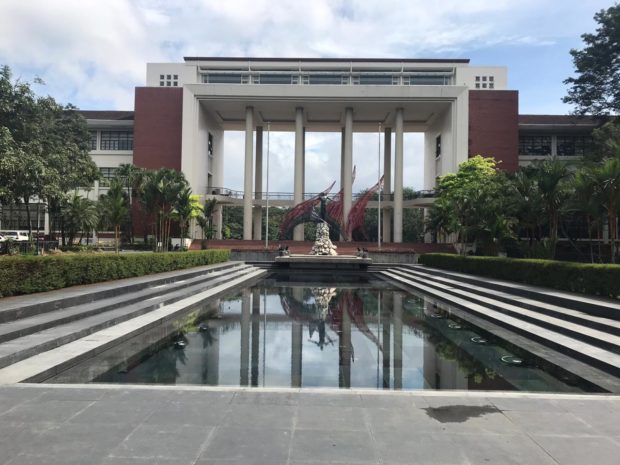UP shifts to blended learning

Facade of the University of the Philippines in Diliman, Quezon City. Photo by Evangeline Valderrama
MANILA, Philippines — After more than two years in a fully online learning setup, the University of the Philippines (UP) will finally be shifting to blended learning starting academic year 2022-2023.
Blended learning is the term given to the educational practice of combining digital learning tools with more traditional classroom in-person teaching.
According to a memorandum issued by the Office of the Vice President for Academic Affairs dated June 20 and made public during the weekend, the country’s premier state university is now preparing to reopen its campuses after seeing an improved COVID-19 situation and vaccination numbers nationwide.
However, the university said it believed that blended learning was now the “ideal learning delivery mode in the postpandemic era.”
“Mixing face-to-face, virtual, and experiential learning is also among the best practices for motivating students and challenging them to engage with the subject matter, develop critical skills, and learn meaningfully,” the memorandum read. “[The] ‘thoughtful fusion’ of instructional modalities and methods improves learning outcomes and provides flexibility for teachers and learners.”
As such, the university will be following three blended learning models with different levels of in-person activities “depending on the target learning objectives and outcomes.”
3 different models
Under Model 1 of its blended online learning, classes will remain fully online, or the same setup adopted in the past two years.
Model 2, or blended block learning, will combine blocks of independent online study with intensive face-to-face sessions.
For example, a laboratory class with students living in different provinces can schedule in-person sessions throughout the semester. A class can also begin with intensive face-to-face classes, followed by online study.
Model 3, or the classic blended learning, alternates face-to-face sessions with asynchronous learning.
Under this approach, students can study the content at home and then do guided practice and group work during in-person classes.
All three models can be implemented under alert levels 1-5. However, face-to-face activities can only be allowed under alert levels 1-3 at varying capacities, and require full vaccination and retrofitted classrooms to observe health protocols.
The memorandum encourages teachers and staff to “think through which learning activities are best done face-to-face or online.”
For example, classes that require laboratory or studio work, field activities, group tutorials, proctored exams and consultations may do face-to-face sessions.
Seminars, tutorials, workshops and online proctored exams may use synchronous online learning, while recorded lectures, assigned readings, automated quizzes, reflection papers and other submissions may be under asynchronous learning.
With these guidelines in mind, educators may now do course design between July 1 and 30, and upload their course packs on their online learning management systems by Aug. 1 to 31.
UP had hoped for a blended learning environment for its students in the second semester of the last academic year, but the uncertainties of the pandemic—health protocols, changing restrictions and vaccination rollout—forced the university to remain in remote mode.
No more face-to-face classes
Other universities and colleges are adopting hybrid learning after the Commission on Higher Education (CHEd) last year adopted such policy as the norm even after COVID-19 has eased.
CHEd Chair Prospero De Vera, in his presentation at the “Educating our Children in the New Normal” webinar organized by the Center for Strategy, Enterprise and Intelligence, said there would be no going back to the traditional full-packed face-to-face classrooms.
He said the commission did not want to “risk exposing educational stakeholders to the same risk if another pandemic comes in” and that going back to the traditional in-person classes would waste the “investments in technology, teachers’ training and retrofitting of our facilities” made during the pandemic.
The Department of Education has also announced plans to resume in-person classes at full capacity by November this year even with the increasing number of COVID-19 cases in the country.
Vice President Sara Duterte, who is also the education secretary, relayed during the first Cabinet meeting in Malacañang her department’s plan for a gradual resumption of in-person classes for the school year 2022-2023 until full capacity is reached after three months.
RELATED STORIES
The promises and pitfalls of blended learning in PH
SWS: 89% of families say blended learning harder than face-to-face classes
Target: 100% in-person classes by November
Disclaimer: The comments uploaded on this site do not necessarily represent or reflect the views of management and owner of Cebudailynews. We reserve the right to exclude comments that we deem to be inconsistent with our editorial standards.
